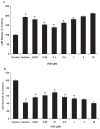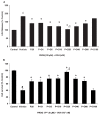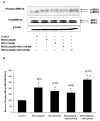Progesterone with vitamin D affords better neuroprotection against excitotoxicity in cultured cortical neurons than progesterone alone
- PMID: 19603099
- PMCID: PMC2710287
- DOI: 10.2119/molmed.2009.00016
Progesterone with vitamin D affords better neuroprotection against excitotoxicity in cultured cortical neurons than progesterone alone
Abstract
Because the complex heterogeneity of traumatic brain injury (TBI) is believed by many to be a major reason for the failed clinical trials of monotherapies, combining two (or more) drugs with some potentially different mechanisms of action may produce better effects than administering those agents individually. In this study, we investigated whether combinatorial treatment with progesterone (PROG) and 1,25-dihydroxyvitamin D(3) hormone (VDH) would produce better neuroprotection than PROG alone following excitotoxic neuronal injury in vitro. E18 rat primary cortical neurons were pretreated with various concentrations of PROG and VDH separately or in combination for 24 h and then exposed to glutamate (0.5 micromol/L) for the next 24 h. Lactate dehydrogenase (LDH) release and 3-(4,5-dimethylthiazol-2-yl)-2,5-diphenyltetrazolium bromide (MTT) reduction assays were used to measure cell death. Both PROG and VDH significantly (P < 0.001) reduced neuronal loss when tested independently. Primary cortical cultures treated with VDH exhibited a U-shaped concentration-response curve. PROG at 20 micromol/L and VDH at 100 nmol/L concentrations were the most neuroprotective. When the drugs were combined, the "best" doses of PROG (20 micromol/L) and VDH (100 nmol/L), used individually, did not show substantial efficacy; rather, the lower dose of VDH (20 nmol/L) was most effective when used in combination with PROG (P < 0.01). We also examined the effect of combinatorial treatment on mitogen-activated protein kinase (MAPK) activation as a potential neuroprotective mechanism and observed that PROG and VDH activated MAPK alone and in combination. Interestingly, the best combination dose of PROG and VDH (20 micromol/L and 20 nmol/L, respectively), as observed in cell death assays (LDH and MTT), resulted in increased MAPK activation compared with either the most neuroprotective concentration of individual PROG (20 micromol/L) and VDH (100 nmol/L) or the combination of these individual best doses. Such interactions must be considered in planning individualized combinatorial therapies. In conclusion, the findings of the present study can be taken to suggest that VDH warrants study as a potential partner for combination therapy with PROG.
Figures






References
-
- Doppenberg EM, Choi SC, Bullock R. Clinical trials in traumatic brain injury: lessons for the future. J Neurosurg Anesthesiol. 2004;16:87–94. - PubMed
-
- Sidaros A, et al. Long-term global and regional brain volume changes following severe traumatic brain injury: a longitudinal study with clinical correlates. Neuroimage. 2009;44:1–8. - PubMed
-
- Behan LA, Agha A. Endocrine consequences of adult traumatic brain injury. Horm Res. 2007;68(Suppl 5):18–21. - PubMed
-
- Wright DW, et al. ProTECT: a randomized clinical trial of progesterone for acute traumatic brain injury. Ann Emerg Med. 2007;49:391–402. - PubMed
Publication types
MeSH terms
Substances
Grants and funding
LinkOut - more resources
Full Text Sources
Other Literature Sources
Medical

